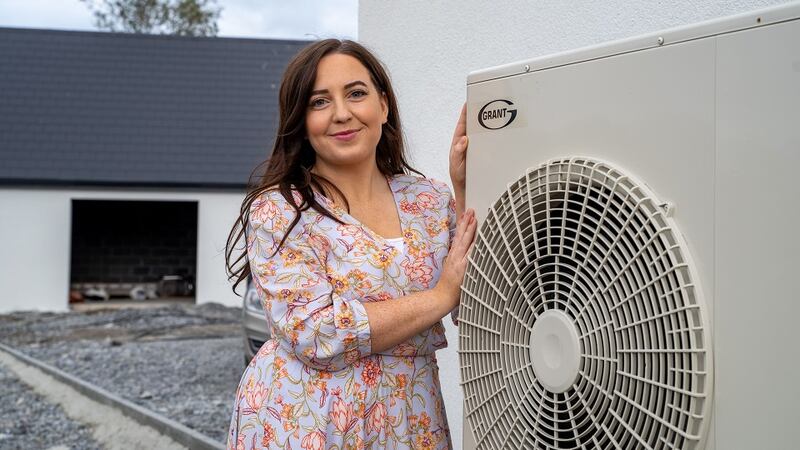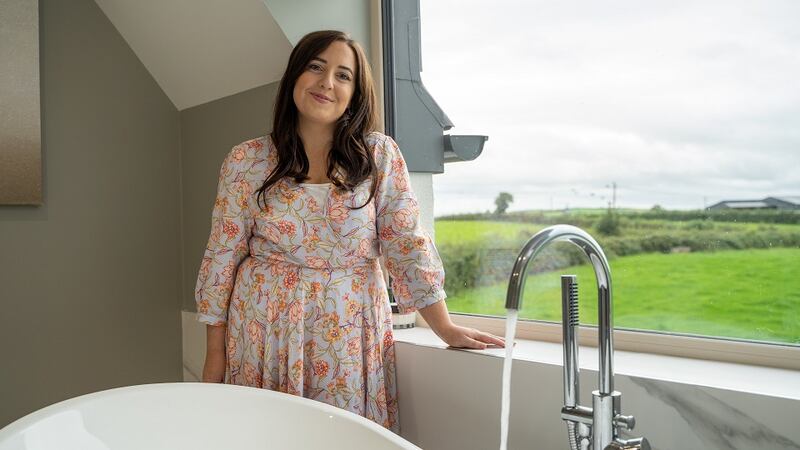When paediatric nurse Katie Grogan sat down three years ago to plan her dream home she had no inkling that she would break ground on her plot just one week before a global pandemic sent Ireland into lockdown.
And if a pandemic wasn’t bad enough, Katie was now expecting her second child and the reality of Brexit was sending carefully laid plans for a family home at Cloghan, Co Offaly, awry.
It sounds like the stuff of nightmares; the last thing anyone undertaking a self-build project needs.
‘We’d moved houses six times and we were dead set on putting down roots and building our own home,’ Katie says.
Putting down roots meant progressing a build as trouble-free as possible and Katie set about documenting every step of the way on her popular Instagram account the-house-near-strawberry-hill, including everything from the beautiful finishes and flourishes, but also every nut, bolt and pipe, as well as her underfloor heating.

"When we planned the house with the architect they went through our options in terms of heating and we realised that an air source heat pump was the way to go, coupled with underfloor heating in each room. We did have the options of radiators as well but we preferred underfloor heating as it meant we didn’t need to worry about placing furniture in front of radiators, and gave us more freedom over the design of the interior," says Katie. "For us the most important things were comfort and cost."
Katie's contractors contacted Birr-based heating specialists Grant, and the team went through the house plans, calculating the heating requirements for each room and correct sizing of all recommended heating technologies, which resulted in a bespoke integrated package for the family home.
"The technical team at Grant literally took care of everything and provided our contractors with a home heating plan for every room which included layout maps which were an absolute godsend for the build. I was also able to use the maps myself dozens of times when I was talking to kitchen designers, electricians, plumbers. It made it so much easier as all the trades knew exactly what was going on," she says.
They opted for a Grant's Aerona3 R32 air-to-water, air source heat pump, which has an ErP rating of A+++, Grant Uflex underfloor heating across two floors, a Grant pre-plumbed hot water cylinder and Grant wireless smart controls.

"You should have seen the plumber when he saw the cylinder, he was delighted. It was class. It really heats up fast, much quicker than other cylinders."
Even with Brexit and Covid-19 threatening the build schedule, Katie and her family, husband Eoghan and her two boys, were moved into their new build home just in time for Christmas last year. And it wasn’t long before the first frosts put the heating system to the test.
We've seen them [heating bills] cut by two-thirds
"With heat pumps it takes a month or so before the house is first fully up to temperature, but when it's there it stays there," says Katie. "We also installed a heat recovery system which moves heat around the house if it detects a cool spot, which is great."
The family has also seen a reduction in their heating bills, added Katie. "We’ve seen them cut by two-thirds, which is amazing."
"I can’t get over the difference really. About six years ago, I was living with my now husband in a cottage outside Cloghan and one day we woke up and the water in the glass in our bedroom had frozen. Now when after moving in here, it was literally snowing outside and we were inside walking around in summer clothes, just lovely and cosy. And we thought, this is it. We’ve made it."

Homeowners around Ireland get in on the act
It wasn’t that long ago that the thought of using a heat pump to keep your home warm was a novelty, an interesting aside on TV property shows such as Grand Designs.
But that was before a climate crisis that has thrown into sharp relief our own carbon footprints and how much energy we consume without a second thought.
And while governments may appear to move slowly, it seems homebuilders around Ireland are getting on with the business of reducing their impact by choosing sustainable heat-pumps to heat their homes and meet all the necessary Part L compliance and requirements for building regulations.
Heat pump technology is not new - if your home has a fridge, it uses a heat exchanger to cool its contents - and heat pumps for central heating use the same technology to extract energy from the outside air to heat your home instead. In a well-insulated home this is a great option as a main heat source and can help to future proof the property.

With a change in building regulations in recent years, the number of heat-pumps installed per year has risen significantly, according to Barry Gorman, national renewable manager at Grant. And the requirements by self-builders to have a more sustainable heating solution is unlikely to stop there. The reasoning is simple, says Gorman: “It satisfies the Big 3 Cs: Carbon, Comfort, Cost."
But if the arguments for heat pumps for new and self-builds are compelling, the choice on offer for those systems can appear bewildering, particularly for homeowners embarking on a self-build where a heating system is but one of many projects they must juggle.
“We’re here for the homeowner right from the start of their self-build journey,” says Gorman. “We want them to have one less thing to worry about, particularly when building their own home.”
The feedback we get from contractors and those in the trade is that they and the homeowner want simplicity when it comes to selecting heating options
“When a contractor comes to us, the first thing we do is review the house plans for the project, calculate the heat requirements for each room of the house, in line with SR:50 requirements, and we then build out a package that meets all requirements. It really is individual for every new-build home. The heating packages are designed by our in-house technical specialists to suit the property and its owner’s lifestyle. All the heating technologies featured within the package are also correctly sized which is vitally important in maximising efficiencies and long-term savings for the homeowner.”
Each of the heating packages typically includes a main heat source, usually a Grant Aerona3 R32 air-to-water, air source heat pump, a Grant integrated hot water storage system and heat emitters including Grant Afinia aluminium radiators or Grant Uflex underfloor heating or both. Grant smart heating controls can also be added to each package.
In Katie's new home, Barry explains that the combination of the Grant Aerona3 heat pump and the underfloor heating, which was the preference of heat emitter on this project, works really well because "both of these systems operate at low temperatures, therefore providing significant carbon and financial savings for the homeowner. Even if external temperatures were to drop as low as -20°, the heat pump's output will modulate up and down depending on the exact climate conditions to ensure ultimate energy efficiency for the home.
“For new build projects, we are the go-to contact for the project’s contractors and trades during the build including builders, plumbers, electricians, architects, engineers and BERs. Our team provides technical back-up to ensure the specifications of technologies is right, all necessary Part L compliance is met under building regulations and importantly that the installation goes smoothly. Once the heating technologies are installed, it will be one of our technicians that visits the site and commissions the system personally for the homeowner,” adds Gorman.
“The feedback we get from contractors and those in the trade is that they and the homeowner want simplicity when it comes to selecting heating options for a new build and sizing the specified items correctly to maximise efficiencies and cost savings for the future. So that’s what we have designed - a simple system that works to achieve these and makes the whole self-build heating journey hassle free.”
For further detail on Grant’s new build integrated heating packages, visit www.grant.eu
[ download Grant’s guide to heating your new build homeOpens in new window ]









